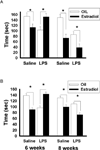A pubertal immune challenge alters the antidepressant-like effects of chronic estradiol treatment in inbred and outbred adult female mice
- PMID: 23036617
- PMCID: PMC3567249
- DOI: 10.1016/j.neuroscience.2012.09.047
A pubertal immune challenge alters the antidepressant-like effects of chronic estradiol treatment in inbred and outbred adult female mice
Abstract
Puberty is a period characterized by brain reorganization that contributes to the development of neural and behavioral responses to gonadal steroids. A single injection of the bacterial endotoxin, lipopolysaccharide (LPS), during the pubertal period decreases sexual receptivity in response to ovarian hormones in adulthood. Because chronic estradiol treatment alleviates depression-like symptoms in ovariectomized adult mice, we investigated the effect of pubertal LPS treatment on estradiol's antidepressant effects. We hypothesized that pubertal LPS treatment would decrease the antidepressant-like effect of estradiol in adult ovariectomized female mice, as it decreases other behavioral responses to ovarian hormones. As expected, chronic estradiol treatment decreased depression-like behavior, as measured by the duration of immobility, in saline-treated mice from two different strains, as well as in mice treated with LPS in adulthood. In contrast, in mice treated pubertally with LPS, estradiol strikingly increased the duration of immobility. No difference in body weight and in locomotion was found among the groups, suggesting that the differences in depression-like behavior were not due to differences in body weight or locomotor activity between LPS-treated and control mice. These results suggest that exposure to an immune challenge during the pubertal period alters the responsiveness of depression-like behavior to estradiol.
Keywords: ANOVA; ER; LPS; analyses of variance; depression; estrogen receptors; forced swim test; lipopolysaccharide; puberty; stress; tail suspension test.
Published by Elsevier Ltd.
Figures






Similar articles
-
Review: Puberty as a time of remodeling the adult response to ovarian hormones.J Steroid Biochem Mol Biol. 2016 Jun;160:2-8. doi: 10.1016/j.jsbmb.2015.05.007. Epub 2015 May 21. J Steroid Biochem Mol Biol. 2016. PMID: 26004504 Free PMC article. Review.
-
Pubertal immune challenge blocks the ability of estradiol to enhance performance on cognitive tasks in adult female mice.Psychoneuroendocrinology. 2013 Jul;38(7):1170-7. doi: 10.1016/j.psyneuen.2012.11.003. Epub 2012 Dec 4. Psychoneuroendocrinology. 2013. PMID: 23218519 Free PMC article.
-
Long-term alteration of anxiolytic effects of ovarian hormones in female mice by a peripubertal immune challenge.Horm Behav. 2011 Sep;60(4):318-26. doi: 10.1016/j.yhbeh.2011.06.005. Epub 2011 Jun 22. Horm Behav. 2011. PMID: 21722643 Free PMC article.
-
Pubertal immune stress transiently alters spatial memory processes in adulthood.Psychoneuroendocrinology. 2019 Apr;102:261-272. doi: 10.1016/j.psyneuen.2018.12.224. Epub 2018 Dec 18. Psychoneuroendocrinology. 2019. PMID: 30594819
-
Sex and age specific effects of delta-9-tetrahydrocannabinol during the periadolescent period in the rat: The unique susceptibility of the prepubescent animal.Neurotoxicol Teratol. 2016 Nov-Dec;58:88-100. doi: 10.1016/j.ntt.2016.02.005. Epub 2016 Feb 16. Neurotoxicol Teratol. 2016. PMID: 26898326 Review.
Cited by
-
What Animal Models Can Tell Us About Long-Term Psychiatric Symptoms in Sepsis Survivors: a Systematic Review.Neurotherapeutics. 2021 Apr;18(2):1393-1413. doi: 10.1007/s13311-020-00981-9. Epub 2021 Jan 6. Neurotherapeutics. 2021. PMID: 33410107 Free PMC article.
-
Antagonising TLR4-TRIF signalling before or after a low-dose alcohol binge during adolescence prevents alcohol drinking but not seeking behaviour in adulthood.Neuropharmacology. 2018 Jan;128:460-473. doi: 10.1016/j.neuropharm.2017.09.028. Epub 2017 Sep 22. Neuropharmacology. 2018. PMID: 28947376 Free PMC article.
-
Microglia and Sensitive Periods in Brain Development.Curr Top Behav Neurosci. 2022;53:55-78. doi: 10.1007/7854_2021_242. Curr Top Behav Neurosci. 2022. PMID: 34463934 Review.
-
Review: Puberty as a time of remodeling the adult response to ovarian hormones.J Steroid Biochem Mol Biol. 2016 Jun;160:2-8. doi: 10.1016/j.jsbmb.2015.05.007. Epub 2015 May 21. J Steroid Biochem Mol Biol. 2016. PMID: 26004504 Free PMC article. Review.
-
Adolescence and Reward: Making Sense of Neural and Behavioral Changes Amid the Chaos.J Neurosci. 2017 Nov 8;37(45):10855-10866. doi: 10.1523/JNEUROSCI.1834-17.2017. J Neurosci. 2017. PMID: 29118215 Free PMC article. Review.
References
-
- Anisman H, Merali Z, Poulter MO, Hayley S. Cytokines as a precipitant of depressive illness: animal and human studies. Curr Pharm Des. 2005;11:963–972. - PubMed
-
- Bernardi M, Vergoni AV, Sandrini M, Tagliavini S, Bertolini A. Influence of ovariectomy, estradiol and progesterone on the behavior of mice in an experimental model of depression. Physiol Behav. 1989;45:1067–1068. - PubMed
-
- Dalla C, Antoniou K, Papadopoulou-Daifoti Z, Balthazart J, Bakker J. Oestrogen-deficient female aromatase knockout (ArKO) mice exhibit depressive-like symptomatology. Eur J Neurosci. 2004;20:217–228. - PubMed
-
- Darnaudery M, Louvart H, Defrance L, Leonhardt M, Morley-Fletcher S, Gruber SH, Galietta G, Mathe AA, Maccari S. Impact of an intense stress on ethanol consumption in female rats characterized by their pre-stress preference: modulation by prenatal stress. Brain Res. 2007;1131:181–186. - PubMed
Publication types
MeSH terms
Substances
Grants and funding
LinkOut - more resources
Full Text Sources
Other Literature Sources
Medical
Molecular Biology Databases
Research Materials

